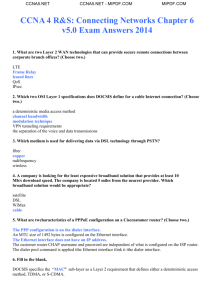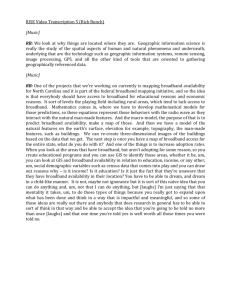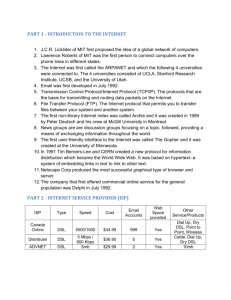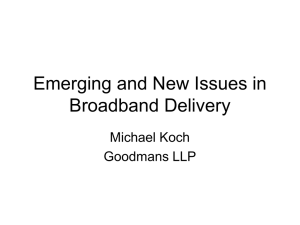Triple Play Services
advertisement
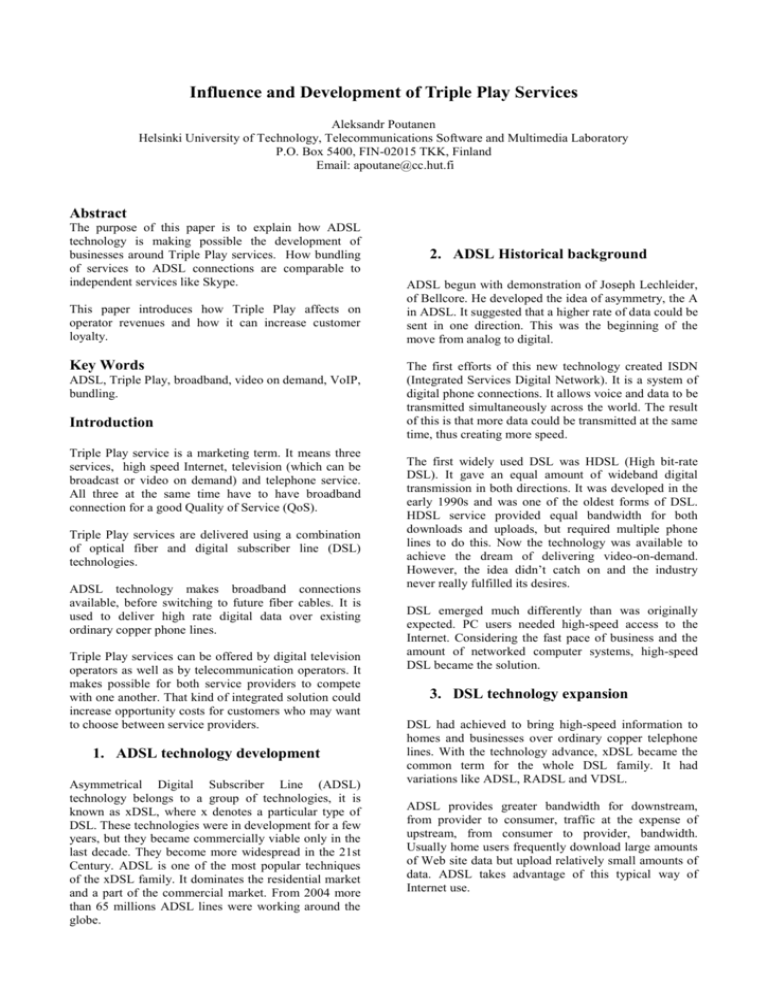
Influence and Development of Triple Play Services Aleksandr Poutanen Helsinki University of Technology, Telecommunications Software and Multimedia Laboratory P.O. Box 5400, FIN-02015 TKK, Finland Email: apoutane@cc.hut.fi Abstract The purpose of this paper is to explain how ADSL technology is making possible the development of businesses around Triple Play services. How bundling of services to ADSL connections are comparable to independent services like Skype. This paper introduces how Triple Play affects on operator revenues and how it can increase customer loyalty. Key Words ADSL, Triple Play, broadband, video on demand, VoIP, bundling. Introduction Triple Play service is a marketing term. It means three services, high speed Internet, television (which can be broadcast or video on demand) and telephone service. All three at the same time have to have broadband connection for a good Quality of Service (QoS). Triple Play services are delivered using a combination of optical fiber and digital subscriber line (DSL) technologies. ADSL technology makes broadband connections available, before switching to future fiber cables. It is used to deliver high rate digital data over existing ordinary copper phone lines. Triple Play services can be offered by digital television operators as well as by telecommunication operators. It makes possible for both service providers to compete with one another. That kind of integrated solution could increase opportunity costs for customers who may want to choose between service providers. 1. ADSL technology development Asymmetrical Digital Subscriber Line (ADSL) technology belongs to a group of technologies, it is known as xDSL, where x denotes a particular type of DSL. These technologies were in development for a few years, but they became commercially viable only in the last decade. They become more widespread in the 21st Century. ADSL is one of the most popular techniques of the xDSL family. It dominates the residential market and a part of the commercial market. From 2004 more than 65 millions ADSL lines were working around the globe. 2. ADSL Historical background ADSL begun with demonstration of Joseph Lechleider, of Bellcore. He developed the idea of asymmetry, the A in ADSL. It suggested that a higher rate of data could be sent in one direction. This was the beginning of the move from analog to digital. The first efforts of this new technology created ISDN (Integrated Services Digital Network). It is a system of digital phone connections. It allows voice and data to be transmitted simultaneously across the world. The result of this is that more data could be transmitted at the same time, thus creating more speed. The first widely used DSL was HDSL (High bit-rate DSL). It gave an equal amount of wideband digital transmission in both directions. It was developed in the early 1990s and was one of the oldest forms of DSL. HDSL service provided equal bandwidth for both downloads and uploads, but required multiple phone lines to do this. Now the technology was available to achieve the dream of delivering video-on-demand. However, the idea didn’t catch on and the industry never really fulfilled its desires. DSL emerged much differently than was originally expected. PC users needed high-speed access to the Internet. Considering the fast pace of business and the amount of networked computer systems, high-speed DSL became the solution. 3. DSL technology expansion DSL had achieved to bring high-speed information to homes and businesses over ordinary copper telephone lines. With the technology advance, xDSL became the common term for the whole DSL family. It had variations like ADSL, RADSL and VDSL. ADSL provides greater bandwidth for downstream, from provider to consumer, traffic at the expense of upstream, from consumer to provider, bandwidth. Usually home users frequently download large amounts of Web site data but upload relatively small amounts of data. ADSL takes advantage of this typical way of Internet use. Technological advances are carrying DSL with them at a fast pace. But eventually some problems like unavailability in certain areas, and poor Quality of Service (slow and interrupted services) challenged the industry. New DSL versions came to change the problems. RADSL (Rate-adaptive DSL) is an ADSL technology utilizing helping software. This software determines delivery rate at which signals can be transmitted and adjust the data rate accordingly. VDSL (Very-high-data-rate DSL) it promises much higher data rates over relatively short distances. It was developed to support exceptionally high-bandwidth applications such as High-Definition Television (HDTV). VDSL relies on fiber optic cabling. First, broadband DSL demand caught fire in the Far East, which, according to industry analyst firm Point Topic, had nearly 8 million DSL subscribers at the end of 2001. This was just a part of the explosion of the global DSL subscriber base to 18.7 million users at the end of 2001. end of 2004 and the end of 2005 was 56.2m. Whereas the third quarter of 2005 showed an increase in the actual number of lines which was definitely higher than in previous quarters, the growth rate in the fourth quarter dropped, returning to the expected average of 8%. While 12.4m lines were added in Q1 2005, 13.1m in Q2 2005, 15.1m in Q3 2005, Q4 2005 showed only a small further gain with 15.5m being added. Quarterly growth in percentage terms remained steady, ranging from 7.9% to 8.4% during 2005. (Table 1) (Mueller Katja (ed.) 2006) We can see that the global trend is stable without any noticeable sign of either slowing down or accelerating, despite exceptionally low penetration rates in many regions and the potential for broadband lines. Figure 1: ‘Top Ten’ broadband countries by population penetration: 31 Dec 2004 - 31 Dec 2005 (Mueller 2006) 4. Finnish and international ADSL market comparison Table 1. DSL lines (in 000's) in major countries: Europe, Middle East and Africa (Mueller 2006) South Korea showed negligible broadband growth in 2005 but still has over 25% penetration of broadband. (Figure 1) Denmark and The Netherlands are only a fraction of a percent behind it. As the graphic shows, Hong Kong and Finland are also close, both having reached a 23% penetration level. Figure 2 Broadband penetration and growth by world region (7): 31 Dec 2005 (Mueller 2006) During the fourth quarter of 2005 the worldwide total of broadband lines grew to 209.3m lines, which increased by 37% from 153.3m lines on 31 December 2004. The total number of broadband lines thus added between the EMEA (Europe, Middle East and Africa) Region is leading increasingly the worldwide roll-out of broadband. The Middle East, Africa and Eastern Europe, are the fastest growing of the seven regions considered as Figure 2 show. Their overall penetration levels are still low. (Figure 2) Western Europe on the other hand has almost caught up with North America as the most high-penetration region, but is still growing considerably faster. Western Europe’s 47% in 2005 as against North Americas 27%. Unless broadband growth in Western Europe goes through a very sharp slowdown, it will soon be ahead of North America. Finland’s broadband penetration is fourth in Europe, which was 33% of the households in January 2005. At the end of December 2003 there were 470,000 total broadband subscribers in Finland. In one year, number of subscribers increased by 60%. Coming to the end of December 2004 the number increased to 750,000. The regional availability of broadband reached 94.1% of the total households. 5. Finland’s biggest players Finland's telecom service inherited its unique structure from history before privatization. The telephone service across the country was mostly in the hands of local, municipal operators. For example Helsinki Telephone Company, now renamed Elisa. Many companies had less than 100,000 lines. Sonera, ex Finnish PTT (the incumbent operator), entered the market to support a municipal phone company. It helped providing local service, long-distance and international service in thinly-populated areas. Same structure has remained mostly same after privatization and in the era of competition. Finland's initiation of new fixed-line technologies, such as DSL has also been fragmented. There are very different experiences in different parts of the country. Sonera Sonera is the major telecommunications operator offering DSL services in Finland. At first, in 1998 the operator offered DSL services to business customers. The offering of high-speed Internet services to business customers begun in June 1999. In May 2000 Sonera launched its first DSL services for residential customers, Home ADSL. Its total broadband customers increased from 279,000 at the end of March 2005 to 302,000 at the end of June 2005. In the third quarter of 2005, Sonera launched ‘ADSL 12 Mbps’ and ‘ADSL 24 Mbps’ which sped up to 24 Mbps. It also reduced the monthly rental prices for all its services in Helsinki and Alastaro regions by up to 33% in its business grade. Elisa Elisa is a telecommunications service provider in Finland, and has international presence with a focus on the Baltic rim. Elisa's total broadband subscribers increased from 308,183 at the end of June 2005 to 345,898 at the end of September 2005. Auria Auria is operator which is wholly owned subsidiary of TeliaSonera Finland after its acquisition in September 2003. The company had 13,000 ADSL subscribers at the end of December 2003. 6. Bundling of services Service providers can increase their subscriber revenues by bundling services and by offering differentiated service levels through Service Level Agreements (SLAs). DSL bundling helps companies reap the benefits of dramatically lowered WAN costs, improved global connectivity, and high reliability, while providing sufficient bandwidth. It also helps to combine such critical traffic as voice and video with data. Bundling VoIP (Voice over IP) or TV/IP with ADSL service is becoming constantly more popular. Internet service provider tries to sell cheap long-distance service. Providers try to grow their profits by bundling cheap voice services with more expensive data services. These plans are good for their businesses. They also can be good for consumers. Reports tell of local phone bills being halved and high-speed Internet access being given away for free. These deals seem to be designed to get you into buying costlier services such as videoconferencing and hosted software applications. Their sales team will try to get you buy their other services. Service providers approach you with a variety of Web-related services such as managed e-mail, site hosting, and secure, Internet-based networks. It is not necessarily bad thing, just possibly more costly, they have to get their profits from somewhere. So once you subscribe to two or more services, you're less likely to change service provider. And once you're locked in, they hope to sell you higher-priced data communications services. (Kevin Fergoson 2002) If you opt for bundling, you should read the SLA (service level agreement) guaranteed by your contract. The SLA has specifics like which provider is responsible for what. Who drops the bill if you lose service? Of course many SLAs offer compensation only for hourly online charges, not the lost sales. Independent providers On the other side there are VoIP service providers such as Vonage and Skype who have changed the competitive landscape by adding a number of calling features and capabilities under flat-rate monthly plans. They are offering videoconferencing and phonecalls over Internet. VoIP (Voice over IP) services typically promise a smaller phone bill, virtually wiping out charges for long-distance and international calls. They bring to customer freedom of choise and also smaller bill for their calls. On the other hand their services can differ dramatically in price or quality. Many subscribers of different VoIP services can't talk to each other. There is no technological obstacle as to why VoIP providers are like little islands. They must share their customer information to connect with another VoIP provider's customers. That is why VoIP carriers are overprotective and act like little fortressess. 7. Bundling mobile and Triple-play services to ADSL Bundling has become the key to many telecom operators growth strategy. Broadband users, whether they are home users or corporate customers, are more likely to have wireless phones. This represents a competitive threat to cable operators who have to respond with their own bundled wireless offering or they risk losing valuable customers. So, the next step in bundling is to combine broadband, particularly ADSL connections, with mobility and get rid off cables. It combines two essential networking functions broadband access to Internet and staying mobile. (Amol Joshi 2004) Triple-play bundles packages consisting of phone, cable TV and high-speed Internet. "Triple-play bundle packages allow residents to have high-quality services and provides low costs by bundling the service for a price that is less than the price of individual services," said Tim Lebel, Arialink Broadband's vice president of operations in Lansing Michigan. While ILECs (incumbent local exchange carriers) strength lies in traditional voice services and the ability to add a wireless technology in the bundle, triple play offers MSOs (multiple system operators) the opportunity to use their better video position, and combine it with broadband Internet and new voice services. With a good network in place, MSOs also have better starting point for services such as video. ILECs will have to focus on bundling and innovative price cutting tactics, wireless services, and integrated home/work offerings that could give better boost to their corporate customer relations. (Frost & Sullivan 2004) 8. Influence of Triple-Play Triple play strategy that bundles voice, video, and data services can be a key determinant of the consumer’s final choice. The Triple Play comes with the promise of increased profits and customer loyalty. It doesn’t come without the risks. By adding more complexity it could end up taxing resources, dragging profits down and ultimately creating more customer churn in the end. That is why for telecommunications carriers and cable service providers who are thinking of adding Triple Play technology to their networks, the idea seems more like Pandora’s Box than low-hanging fruit. The service that will make triple play stay is broadband TV, and this is starting to influence the broadcasting industry. Broadcasters have been slow to embrace these digital technologies. They have feared that this would bring more competition by opening new market, but digital broadcasting has more to do with access to new services than developing new content. It allows access to the emerging IP-based broadband services. Now, a lot of new digital broadcasters are rapidly moving into the broadband areas and telecommunications in general. Governments around the world are unable to elicit significant public interest in broadband, digital TV after legislating for the transition from analogue to digital TV. Most models are based on the old broadcasting model and very few viewers so far have been prepared to pay big money for more of the same TV. The disappearance of VCR and the birth of the DVR have increased demand for better user experiences. The birth of these new services, have driven customers away from PCs towards plasma screens and HDTV. This can increase customer loyalty significantly. References Charmy Ben 2003, VoIP – a Tower of Babel?, News.com Frost & Sullivan (ed.) 2004, North American Triple Play Outlook Amol Joshi (ed.) 2004, Bundling wireless with Broadband Mueller Katja (ed.) 2006. World Broadband Statistics: Q4 2005 Point-Topic (ed) 2006. http://www.pointtopic.com/home/operatorSource/profiles.asp?group=Eur ope Fergoson Kevin 2002. BusinessWeek http://en.wikipedia.org/wiki/Triple_play_(telecommuni cations) http://e.finland.fi/ http://www.stat.fi/ http://www.ficora.fi/suomi/index.html
